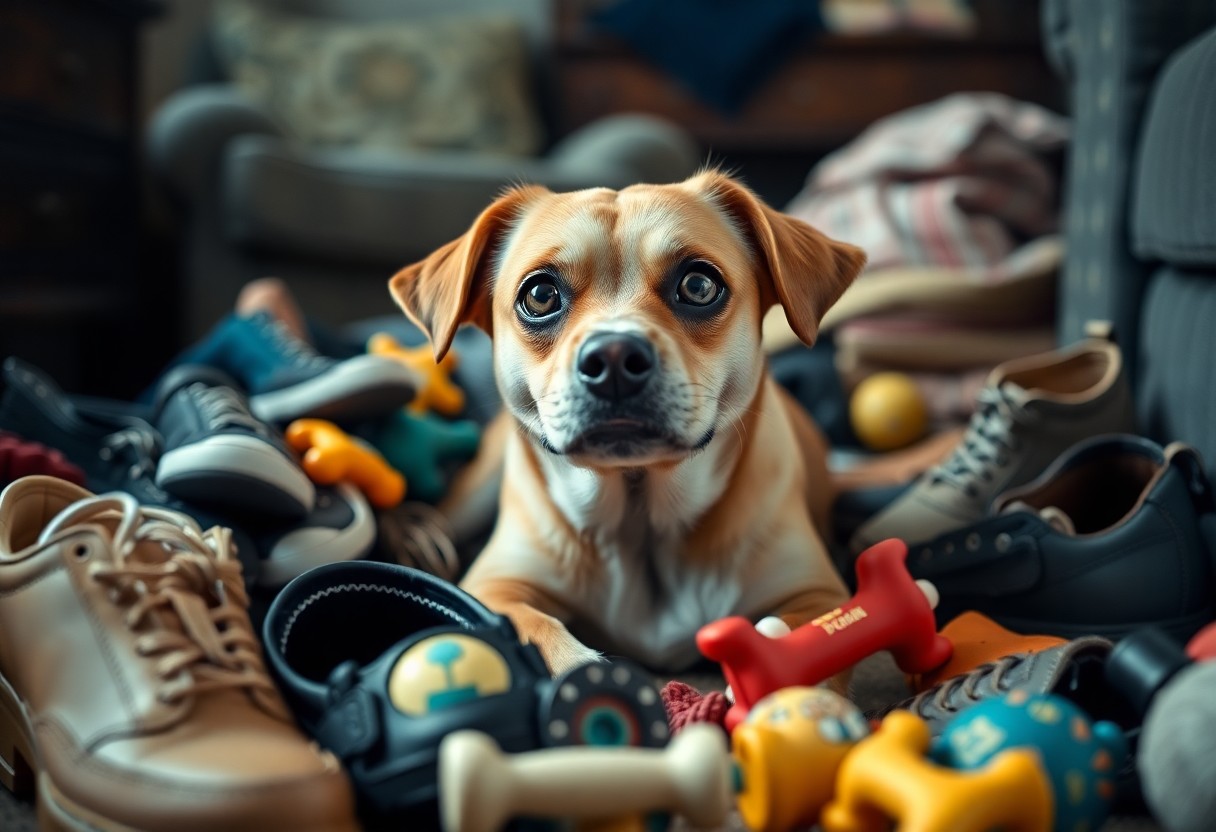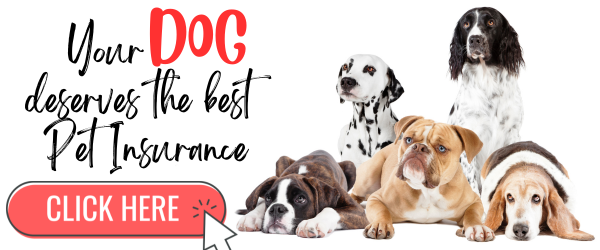Overwhelming curiosity and natural instincts often lead your dog to chew everything in sight. Chewing helps your dog explore their environment, relieve stress, and maintain healthy teeth and gums. However, excessive chewing can indicate boredom, anxiety, or dental issues, which might require your attention. Understanding your dog’s behavior allows you to provide appropriate chew toys and training, preventing damage to your belongings and ensuring your pet’s safety. By addressing this behavior thoughtfully, you support your dog’s wellbeing and create a harmonious home.
Understanding Dog Behavior
Your dog’s chewing habits are deeply rooted in their natural behaviors and environment. By understanding the reasons behind their chewing, you can better manage their actions and keep your home safe. Dogs chew for various reasons, including teething, boredom, or to explore their surroundings. This behavior is an crucial part of how they interact with the world and communicate their needs, so observing your dog’s patterns helps you support their well-being effectively.
Natural Chewing Instincts
Natural chewing instincts in dogs come from their wild ancestors, who used chewing to keep their teeth clean and jaws strong. Chewing also helps dogs relieve stress and prevents boredom. When you provide suitable chew toys, you channel this instinct positively, protecting your belongings and promoting your dog’s dental health.
Developmental Stages
Across your dog’s life, their chewing behavior changes, especially during puppyhood. Puppies chew more intensely to ease teething pain and learn about their environment. As they mature, the reasons for chewing often shift toward stimulation or anxiety, requiring different management strategies from you to encourage good habits.
But it’s important to intervene early during the developmental stages to avoid destructive chewing. If left unchecked, chewing can lead to dangerous ingestion of harmful objects or create lasting habits that are hard to change. You can support your dog by offering appropriate chew toys and engaging them in regular play and exercise to meet their physical and emotional needs.
1. Dogs chew to explore their environment and relieve boredom.
2. Teething causes puppies to chew more frequently.
3. Anxiety or stress can trigger excessive chewing behavior.
4. Lack of exercise leads to destructive chewing out of energy.
5. Providing chew toys helps redirect chewing habits appropriately.
6. Training and supervision reduce unwanted chewing and protect belongings.
Common Reasons for Chewing
One of the main reasons your dog is chewing everything is because it’s a natural behavior driven by various needs. Chewing can be a way for your dog to relieve stress, satisfy curiosity, or deal with discomfort. Understanding these reasons helps you manage this behavior effectively and protect your belongings while ensuring your dog stays happy and healthy.
Boredom and Anxiety
By experiencing boredom or anxiety, your dog may turn to chewing as a way to self-soothe or entertain itself. If your dog doesn’t receive enough mental or physical stimulation, chewing becomes a way to release pent-up energy. Addressing your dog’s need for engagement can significantly reduce destructive chewing and promote a calmer, more content pet.
Teething and Exploring
On a developmental level, puppies chew to alleviate the discomfort of teething and to explore their environment. This behavior is a natural part of growing up, helping your puppy learn about the world while soothing sore gums. Providing appropriate chew toys can help direct this behavior away from your belongings.
Also, as your dog matures, chewing continues to serve as a way to explore and interact with their surroundings. Offering safe, durable chew toys not only protects your home but supports positive behavioral growth. Be mindful that chewing inappropriate items can pose serious health risks, such as choking or digestive blockages, so supervision and training are vital during this phase.
Identifying Problematic Chewing
Now, to manage your dog’s chewing effectively, you need to distinguish between normal and problematic biting behaviors. Problematic chewing often results in damage to your belongings, while normal chewing is part of healthy development, especially in puppies. Understanding this difference helps you address the root cause and prevent future issues.
Distinguishing Normal from Destructive
With normal chewing, your dog typically targets appropriate toys, showing contentment and curiosity. Destructive chewing, however, involves items like shoes or furniture, sometimes accompanied by signs of anxiety or boredom. Observing when and what your dog chews can guide you to the right interventions and keep your home safe.
Recognizing Triggers
The triggers behind your dog’s chewing can vary from anxiety and stress to lack of exercise or teething in young pups. Identifying these triggers allows you to create a more enriching environment that can reduce destructive behavior and promote healthier habits.
Triggers such as separation anxiety, boredom, or insufficient mental stimulation play a significant role in why your dog might chew excessively. By noting the context and timing of chewing episodes, you can pinpoint specific causes and address them, whether by increasing playtime, providing interactive toys, or calming techniques that alleviate the discomfort your dog experiences.

Solutions to Mitigate Chewing
Once again, tackling your dog’s chewing behavior requires a combination of strategies tailored to your pet’s needs. Focusing on redirection, supervision, and providing mental stimulation can significantly reduce destructive chewing. By actively managing your dog’s environment and offering appropriate outlets for this natural behavior, you will help preserve your belongings and support your dog’s well-being.
Providing Appropriate Chew Toys
After identifying that your dog needs a healthy outlet for chewing, offering durable and safe chew toys is important. Select toys that suit your dog’s size and chewing strength to prevent choking hazards or damage. Rotate the toys regularly to maintain your dog’s interest, and consider toys that challenge their mind and help with teething discomfort, ensuring your dog satisfies their natural urge without resorting to furniture or shoes.
Training Techniques
Techniques that reinforce positive behavior while discouraging destructive chewing are effective tools in your training arsenal. Using commands such as “leave it” or “no,” combined with positive reinforcement when your dog chooses the correct item to chew, enhances learning. Consistency and patience are key, as well as offering redirection to approved chew toys the moment unwanted chewing begins.
Training works best when you are proactive, guiding your dog through clear expectations. Start by supervising your dog closely and interrupting any inappropriate chewing immediately. Redirect them gently to an approved chew toy and praise them enthusiastically for choosing the right object. Over time, your dog will associate chewing only with these toys, which helps reduce frustration and confusion. Incorporate daily exercise and mental challenges to reduce boredom, a common cause of destructive chewing. Training with kindness and clear boundaries strengthens your bond and empowers your dog to make better choices.
When to Seek Professional Help
To ensure your dog’s chewing habit doesn’t lead to harm or worsen, you need to recognize when professional intervention is necessary. If your dog’s chewing becomes excessive, destructive, or accompanied by other troubling behaviors, consulting experts can provide guidance tailored to your pet’s needs, helping both of you find relief and restore harmony in your home.
Signs of Behavioral Issues
At times, chewing is more than just playful exploration; it can signal underlying behavioral problems. If your dog chews relentlessly, destroys furniture, or displays anxiety, restlessness, or aggression, these signs suggest that you should seek advice from a behavior specialist to address potential emotional or psychological triggers.
Veterinary Consultation
An appointment with your vet can uncover health-related causes behind your dog’s chewing. Medical issues, such as dental pain, nutritional deficiencies, or parasites, might be driving the behavior, and professional assessment ensures your dog receives appropriate treatment or management strategies.
Even if you suspect the chewing is purely behavioral, a veterinary consultation is beneficial. Your vet can rule out health problems and possibly recommend referral to a certified animal behaviorist. This approach ensures early detection of serious conditions and sets your dog on a path to better well-being and happier habits. Ignoring signs could lead to worsening behavior or unnoticed medical issues, so professional input supports both safety and positive outcomes for your furry friend.
Preventive Measures
All dog owners benefit from adopting strong preventive measures to curb your pet’s chewing habits. Providing appropriate outlets for chewing, maintaining a disciplined routine, and ensuring a safe environment can significantly reduce destructive behavior. You need to observe your dog’s behavior carefully and intervene early to redirect their chewing to acceptable items.
Creating a Safe Environment
Along with supervision, you should dog-proof your home by removing or securing objects that pose hazards if chewed, such as electrical cords and toxic plants. Offering durable chew toys within easy reach helps divert your dog’s attention to safe alternatives, preventing unwanted damage and protecting your pet from harm.
Routine and Engagement
The key to managing chewing lies in keeping your dog mentally and physically stimulated throughout the day. Regular exercise and interactive play reduce boredom, which is often a leading cause of destructive chewing, and reinforce positive behaviors you want to see.
It’s important to incorporate varied activities into your dog’s daily routine, including training sessions and puzzle toys that challenge their mind. This combination not only satisfies their natural chewing instinct in a healthy way but also fosters a stronger bond between you and your dog, making behavior management more effective overall.
Final Words
As a reminder, when your dog is chewing everything, it’s often a way for them to relieve stress, boredom, or teething discomfort. By understanding these underlying causes and providing appropriate chew toys, mental stimulation, and regular exercise, you can help redirect this behavior. If you notice excessive or destructive chewing, it’s important to evaluate your dog’s environment and routine, and consider consulting a veterinarian or trainer for additional guidance. Taking proactive steps will ensure your dog stays happy and your belongings remain intact.
 wagwagtail "only love can make your dog wag her tail"
wagwagtail "only love can make your dog wag her tail"
